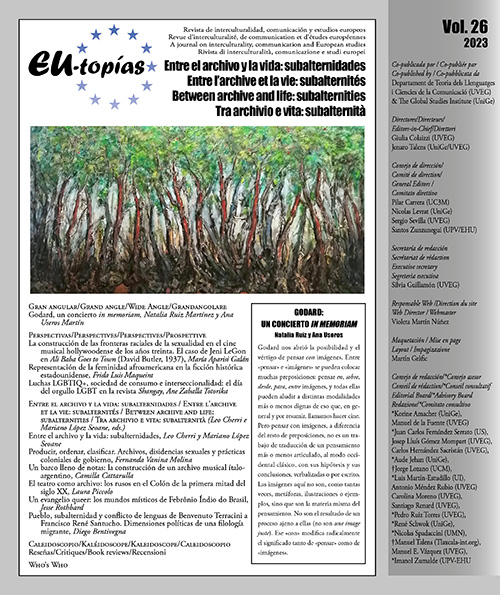LGBTIQ+ struggles, consumer society and intersectionality: LGBT Pride Day in Shangay magazine
DOI:
https://doi.org/10.7203/eutopias.26.26849Keywords:
LGBTIQ , consumer society, gender, pride, intersectionality. Abstract
Abstract
This paper analyzes the representation of the LGTBIQ+ community from the approach of intersectional studies, with the aim of identifying advertising techniques and strategies in relation to the LGBTIQ+ public in the context of consumer society. To this end, the case study focuses on the analysis of the representation of the LGBTIQQ+ community in images of the «Pride Special» issues of Shangay magazine between 2017 and 2022. Thus, the text is meant as an accounting of such identities and the ways in which each of them are presented, thereby identifying the interests that lie in advertising and mercantile terms, and their contribution (or lack thereof) to the visibilization of the collective in a diverse and inclusive way.
 Downloads
Downloads
 References
References
Balmaceda, Gabriel. Biografía no autorizada de 1910. Buenos Aires: Sudamericana, 2010.
Bates, Héctor, Luis Bates. La historia del tango. Buenos Aires: Taller Gráfico de la Cía Gral Fabril Financiera, 1936.
Carella, Tulio. Tango, mito y esencia. Buenos Aires: CEAL, 1966.
Cuneo, Niccolò. Storia dell’emigrazione italiana in Argentina 1810-1870. Milán: Garzanti, 1940.
Franzina, Emilio. «Le canzoni dell’emigrazione». Storia dell’emigrazione italiana. I, Partenze. eds. Piero Bevilacqua, Andreina De Clementi y Emilio Franzina. Roma: Donzelli, 2001, pp. 537-562.
Gesualdo, Vicente. «Las bandas militares. El coraje a través del ritmo». Todo es historia, n. 133 (junio de 1978), pp. 8-31.
Gobello, José. Crónica general del tango. Buenos Aires: Editorial Fraterna, 1980.
Guadagnini, Giuseppe. In America, Repubblica Argentina. Da Buenos Ayres al Capo delle Vergini. Repubblica del Brasile. Da Rio de Janeiro al paese delle Amazzoni. Milán: Zanoletti & Dumolard, 1892, 2 v.
Malvagni, Antonino. Mis treinta años de vida artística en la República Argentina. Buenos Aires: Talleres Gráficos de la Editorial «Italia», 1931.
Mascia, Alfredo. Tango y política. Buenos Aires: Paidós, 1970.
Modrich, Giuseppe. Repubblica Argentina. Note di viaggio da Buenos Aires alla Terra del Fuoco. Milán: Galli, 1890.
Musri, F. Graciela. Músicos inmigrantes. La familia Colecchia en la actividad musical de San Juan 1880-1910. San Juan: EFFHA, 2004.
Ostuni, Ricardo. Tango, voz cortada de organito. La inmigración italiana y su influencia. Buenos Aires: Lumiere, 2005.
Petriella, Dionisio. Los italianos en la historia de la cultura argentina. Buenos Aires: Asociación Dante Alighieri, 1979.
Petriella, Dionisio y Sara Sosa Miatello. Diccionario biográfico ítalo-argentino. Buenos Aires: Asociación Dante Alighieri, 1976.
Pujol, Sergio A. Las canciones del inmigrante. Buenos Aires: espectáculo y proceso inmigratorio. De 1914 a nuestros días. Buenos Aires: Editorial Almagesto, 1989.
Ravveduto, Marcello. «Tra Napoli e Buenos Aires: una rotta musicale dell’emigrazione italiana». Buenos Aires Italiana. Buenos Aires: Comisión para la Preservación del Patrimonio Cultural de la Ciudad Autónoma de Buenos Aires, 2009, pp. 137-148.
Rebuffo, Luis. Un inmigrante piamontés en la Argentina, 1904-1987. Rosario: Ed. La Fiama, [s.a.], 3 v.
Rubio, Héctor. «La presencia de la música italiana y de los músicos italianos en el desarrollo de la música en Argentina». América Latina y la cultura artística italiana: un balance en el Bicentenario de la Independencia Latinoamericana. Ed. Mario Sartor. Buenos Aires: Istituto Italiano di Cultura, 2011, pp. 403-429.
Tallón, José S. El tango en sus etapas de música prohibida. Buenos Aires: Amigos del Libro Argentino, 1964.
Tizziani, Rubén. «E la violeta la va, la va… La impronta italiana en el tango». Il ricordo e l’immagine. Vecchia e nuova identità italiana in Argentina. Ed. Ilaria Magnani. Santa Maria Capua a Vetere: Edizioni Spartaco, 2007, pp. 105-122.
Vidart, Daniel. El tango y su mundo. Montevideo: Ediciones Tauro, 1967.
Downloads
Published
How to Cite
-
Abstract187
-
PDF (Español)91
Issue
Section
License
![]()
The authors conserve the copyright. All content published in EU-topías. Journal of interculturality, Communication, and European Studies are subject to the license Creative Commons Attribution-NonCommercial-ShareAlike 4.0 license. The full text of the license can be found at <http://creativecommons.org/licenses/by-nc-sa/4.0>
They may be copied, used, disseminated, transmitted and publicly displayed, provided that:
- The authorship and original source of the publication is cited (journal, publisher and URL of the work).
- They are not used for commercial purposes.
- The existence and specifications of this license of use are mentioned.
It is the responsibility of the authors to obtain the necessary permissions for images that are subject to copyright.



